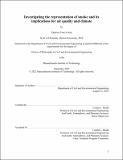Investigating the representation of smoke and its implications for air quality and climate
Author(s)
Carter, Thérèse (Tess)
DownloadThesis PDF (41.21Mb)
Advisor
Heald, Colette L.
Terms of use
Metadata
Show full item recordAbstract
Smoke from biomass burning (both wildfires and prescribed and agricultural burns) is important for atmospheric chemistry and composition, air quality, and climate. These impacts are associated with substantial societal implications such as large detrimental health burdens, lost work and school days, and diminished visibility and ability to use the outdoors. However, there are large uncertainties in the magnitude and characteristics of smoke, stemming from considerable unknowns in all parts of the fire system, and thus in our representation of this in models. This thesis aims to address many of these uncertainties with a multipronged approach using models and observations across scales.
The scope of the research completed herein is introduced and described in Chapter 1. Chapter 2 focuses on how smoke emissions uncertainties carry through to air quality and radiative impacts with an emphasis on North America using four commonly used smoke inventories, a chemical transport model, and observational constraints, including surface networks, aircraft, and satellites. We show that two of the inventories (GFED4s and GFAS) direct the model closest to observations. While most air quality and climate studies only use one smoke inventory, we find that there is a large range across the inventories in health-relevant surface smoke concentrations and climate-relevant direct radiative effects. Chapter 3 investigates carbonaceous aerosol and its absorption properties from fires in two large fire source regions, the western US and Africa, using observations from three aircraft campaigns focused on fires. We find that smoke from African fires is more absorbing than that in the western US and thus that global climate models need to represent regional heterogeneity in absorption properties. We also show that a 1-day whitening lifetime of brown carbon matches observations well and substantially decreases the warming contribution of biomass burning. Chapter 4 expands the model representation of non-methane organic gases (NMOGs) from fires and investigates how important fires are for atmospheric reactivity. This is the first global estimate of the impact of fire on atmospheric reactivity. Chapter 5 focuses on two quantifiable human levers (human-ignited wildfires and agricultural fires) on smoke particulate matter under 2.5 microns in the US. We calculate that these two human drivers account for over 80% of important health metrics (population-weighted exposure and premature mortality) associated with fires, suggesting large mitigation potential of smoke impacts. Finally, Chapter 6 summarizes the work completed in this thesis.
Date issued
2022-09Department
Massachusetts Institute of Technology. Department of Civil and Environmental EngineeringPublisher
Massachusetts Institute of Technology